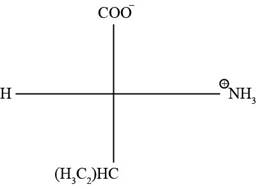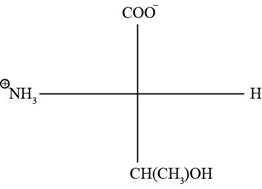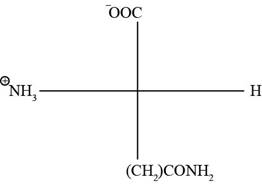
(a) Interpretation:
The amino acid in Fischer projection and interpret it as D- or L- enantiomer.
Concept introduction:
Fischer projections are the representation of bonds by using horizontal and vertical lines in the 3D state. The horizontal lines represent the bonds that are out of paper towards the vision and the vertical lines represent the bonds pointing out the back of the paper away from vision. The intersection between the two lines represents the carbon atom.
A carbon which has all the four different atoms or group of atoms has tetrahedral geometry and such carbon molecule is referred to as the chiral carbon. The two different forms in which a single chiral center can exist is referred to as enantiomers. Simply, the substances which show optical isomerism exist as two isomers known as enantiomers. Enantiomers are non-super imposable mirror images of each other. The number of enantiomers of a molecule depends on the number of chiral centers.
Pictorial representation:
The Fischer projection of the given amino acidvaline is represented as below:

Fig. 1(a): Fischer projection of valine.
(b) Interpretation:
The amino acid in Fischer projection and interpret it as D- or L- enantiomer.
Concept introduction:
Fischer projections are the representation of bonds by using horizontal and vertical lines in the 3D state. The horizontal lines represent the bonds that are out of paper towards the vision and the vertical lines represent the bonds pointing out the back of the paper away from vision. The intersection between the two lines represents the carbon atom.
A carbon which has all the four different atoms or group of atoms has tetrahedral geometry and such carbon molecule is referred to as the chiral carbon. The two different forms in which a single chiral center can exist is referred to as enantiomers. Simply, the substances which show optical isomerism exist as two isomers known as enantiomers. Enantiomers are non-super imposable mirror images of each other. The number of enantiomers of a molecule depends on the number of chiral centers.
Pictorial representation:
The Fischer projection of threonine is represented as below.

Fig. 2(a): Fischer projection of threonine.
(c) Interpretation:
The amino acid in Fischer projection and interpret it as D- or L- enantiomer.
Concept introduction:
Fischer projections are the representation of bonds by using horizontal and vertical lines in the 3D state. The horizontal lines represent the bonds that are out of paper towards the vision and the vertical lines represent the bonds pointing out the back of the paper away from vision. The intersection between the two lines represents the carbon atom.
A carbon which has all the four different atoms or group of atoms has tetrahedral geometry and such carbon molecule is referred to as the chiral carbon. The two different forms in which a single chiral center can exist is referred to as enantiomers. Simply, the substances which show optical isomerism exist as two isomers known as enantiomers. Enantiomers are non-super imposable mirror images of each other. The number of enantiomers of a molecule depends on the number of chiral centers.
Pictorial representation:
The Fischer projection of glutamine is represented as below:

Fig. 3(a): Fischer projection of glutamine.
Want to see the full answer?
Check out a sample textbook solution
Chapter 5 Solutions
BIOCHEMISTRY BOOKS ALC&MOD MST/ET PKG
- write the ionization equilibrium for cysteine and calculate the piarrow_forwardplease answerarrow_forwardf. The genetic code is given below, along with a short strand of template DNA. Write the protein segment that would form from this DNA. 5'-A-T-G-G-C-T-A-G-G-T-A-A-C-C-T-G-C-A-T-T-A-G-3' Table 4.5 The genetic code First Position Second Position (5' end) U C A G Third Position (3' end) Phe Ser Tyr Cys U Phe Ser Tyr Cys Leu Ser Stop Stop Leu Ser Stop Trp UCAG Leu Pro His Arg His Arg C Leu Pro Gln Arg Pro Leu Gin Arg Pro Leu Ser Asn Thr lle Ser Asn Thr lle Arg A Thr Lys UCAG UCAC G lle Arg Thr Lys Met Gly Asp Ala Val Gly Asp Ala Val Gly G Glu Ala UCAC Val Gly Glu Ala Val Note: This table identifies the amino acid encoded by each triplet. For example, the codon 5'-AUG-3' on mRNA specifies methionine, whereas CAU specifies histidine. UAA, UAG, and UGA are termination signals. AUG is part of the initiation signal, in addition to coding for internal methionine residues. Table 4.5 Biochemistry, Seventh Edition 2012 W. H. Freeman and Company B eviation: does it play abbreviation:arrow_forward
- Answer all of the questions please draw structures for major productarrow_forwardfor glycolysis and the citric acid cycle below, show where ATP, NADH and FADH are used or formed. Show on the diagram the points where at least three other metabolic pathways intersect with these two.arrow_forwardanswer the questions please all of them should be answeredarrow_forward
- Burk plot is shown below. Calculate Km and max for this enzyme. show workarrow_forwardInsert Format Tools Extensions Help Normal text ▾ Arial C 2 10 3 + BIUA Student Guide (continued) Record data and conclusions about the mystery food sample either below or in a lab notebook. Step 2: Protein Test (Biuret Solution) Gelatin Water [Mystery Food (Positive Control) (Negative Control) Sample pink purple no change no change They mystery food sample does not contain protein because the color of the test tube wasn't pink or purple Color Conclusion They mystery food sample does not contain protein because the color of the test tube wasn't pink or purple Step 3: Lipid Test (Sudan Red Solution) Vegetable Oil Water (Positive Control) (Negative Control) Mystery Food Sample floating red no change floating red the mystery food dosnt contain lipids because the test tube has floating red 75 % 87 8 9 7 ChromeOS C Device will pow 26.battery lea powerarrow_forwardThe rate data from an enzyme catalyzed reaction with and without an inhibitor present is found in the image. Question: what is the KM and Vm and the nature of inhibitionarrow_forward
- 1. Estimate the concentration of an enzyme within a living cell. Assume that: (a): fresh tissue is 80% water and all of it is intracellular (b): the total soluble protein represents 15% of the weight (c): all the soluble proteins are enzymes (d): the average molecular weight of the proteins is 150,000 (E): about 100 different enzymes are present please help I am lostarrow_forwardPlease helparrow_forwardThe following data were recorded for the enzyme catalyzed conversion of S -> P. Question: Estimate the Vmax and Km. What would be the rate at 2.5 and 5.0 x 10-5 M [S] ?arrow_forward
 BiochemistryBiochemistryISBN:9781319114671Author:Lubert Stryer, Jeremy M. Berg, John L. Tymoczko, Gregory J. Gatto Jr.Publisher:W. H. Freeman
BiochemistryBiochemistryISBN:9781319114671Author:Lubert Stryer, Jeremy M. Berg, John L. Tymoczko, Gregory J. Gatto Jr.Publisher:W. H. Freeman Lehninger Principles of BiochemistryBiochemistryISBN:9781464126116Author:David L. Nelson, Michael M. CoxPublisher:W. H. Freeman
Lehninger Principles of BiochemistryBiochemistryISBN:9781464126116Author:David L. Nelson, Michael M. CoxPublisher:W. H. Freeman Fundamentals of Biochemistry: Life at the Molecul...BiochemistryISBN:9781118918401Author:Donald Voet, Judith G. Voet, Charlotte W. PrattPublisher:WILEY
Fundamentals of Biochemistry: Life at the Molecul...BiochemistryISBN:9781118918401Author:Donald Voet, Judith G. Voet, Charlotte W. PrattPublisher:WILEY BiochemistryBiochemistryISBN:9781305961135Author:Mary K. Campbell, Shawn O. Farrell, Owen M. McDougalPublisher:Cengage Learning
BiochemistryBiochemistryISBN:9781305961135Author:Mary K. Campbell, Shawn O. Farrell, Owen M. McDougalPublisher:Cengage Learning BiochemistryBiochemistryISBN:9781305577206Author:Reginald H. Garrett, Charles M. GrishamPublisher:Cengage Learning
BiochemistryBiochemistryISBN:9781305577206Author:Reginald H. Garrett, Charles M. GrishamPublisher:Cengage Learning Fundamentals of General, Organic, and Biological ...BiochemistryISBN:9780134015187Author:John E. McMurry, David S. Ballantine, Carl A. Hoeger, Virginia E. PetersonPublisher:PEARSON
Fundamentals of General, Organic, and Biological ...BiochemistryISBN:9780134015187Author:John E. McMurry, David S. Ballantine, Carl A. Hoeger, Virginia E. PetersonPublisher:PEARSON





